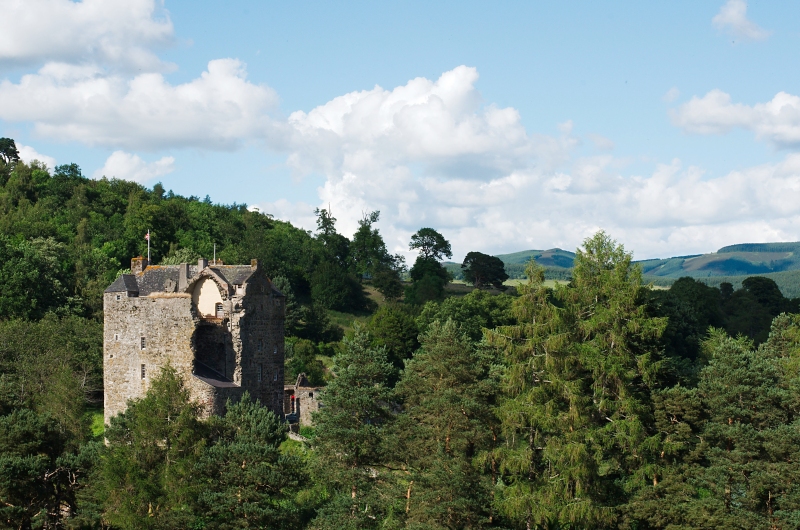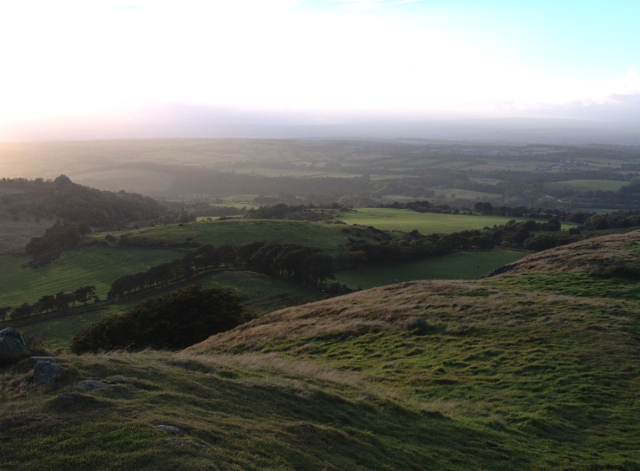
The road parallels the River Tweed as it twists along a tortuous route through the Moorfoot Hills. Rays of sun stretch down from breaks in the clouds, creating long streaks of silver across the river and illuminating rocks and boulders, barely submerged with a smooth surge of water flowing over the tops.
Traffic picks up a bit as we arrive in Peebles, a royal burgh from the reign of David I. Driving through town, we get a quick glimpse of the Cross Kirk which was founded in 1261 by Alexander III. Any thought that enters our minds of stopping for a closer look is quickly discounted; the native drivers are restless and the main thoroughfare has taken on the feel of the Indianapolis 500.
We also get a glimpse of Neidpath Castle as we head west, a site that was on our "if we have time" list. We don't have time; we have so far west and north to travel yet. We drink in all that we can with our eyes as we pass by.
Leaving the River Tweed behind, we continue west into the countryside. Dinner will be late this evening, with Robin's friends Rena, Martin and "Big Bad" Jim. We've not stocked up well on snacks, and start keeping an eye out for a lunch stop.
There's very little to be seen in this area of Midlothian – pasture land and sheep, stone fences, an occasional farm close enough to the road to see the house. But for the most part, it's a virtual no-man's land, a windswept wilderness with the Pentland Hills rising to the north.
In the town of Newbigging we spy a pub and pull in to the car park. The Nestler's Inn; sounds cozy enough. Soon we are seated at a table the shape and almost the size of a Frisbee where we are tended by a very kind woman who points out the specials board to us. I order a cheese toastie, the first of a succession of cheese toasties over the course of the next several days, then sit back to survey my surroundings.
After only a few moments I have mentally pronounced this a "proper pub". The high polished bar is well-stocked with domestic and imported whiskies, including Jack Daniels, and there are several local brews on tap. A rack of antlers adorns the wall above a shelf of trophies; hard-won and well earned I'm sure, but I can't remember if they were for football, squash or, possibly even darts. Burgeoning coleus plants line the windowsills and a bell tinkles on the door as two women with a toddler arrive.
Across the room I notice a board listing the time and other particulars for the weekly pub trivia contest. This makes me smile, picturing this place full of local residents, drinking and laughing. I can almost hear the good-natured banter being shouted out above lively music and the clinking of glasses and bottles. An AOL chat-room that I frequent, the UK Pub Quiz, comes to mind and I wish we could be here to witness and perhaps even participate in this weekly event.
Our meals arrive quickly, and we tuck in, hungrier than we thought we were. We don't linger long here; Torphichen and Linlithgow call from the north.

West Lothian, also known as Linlithgowshire, lies on the southern shore of the Firth of Forth and is predominantly rural, though there were extensive coal, iron, and shale oil mining operations in the 18th and 19th centuries.
The region was extensively settled in prehistoric times, and several ancient burial sites have been uncovered, such as at Cairnpapple Hill. There are remains of hillforts on Cockleroy, Peace Knowe, Bowden, Cairnpapple, and Binns Hills. The area was anciently inhabited by Britons. By 83 AD, southern Scotland had been conquered by Romans, who built a road from their fort at Cramond to the eastern end of the Antonine Wall, as well as forts in West Lothian.
The Romans withdrew roughly two centuries later, and the area was left to the Britons until the arrival of Anglo-Saxons in the fifth and sixth centuries, who brought Lothian under the rule of the Kingdom of Northumbria. In later centuries the region was regularly overrun by Gaelic-speaking Scots, and it became permanently part of the Kingdom of Scotland in the 11th century.
Read more about West Lothian at Wikipedia.